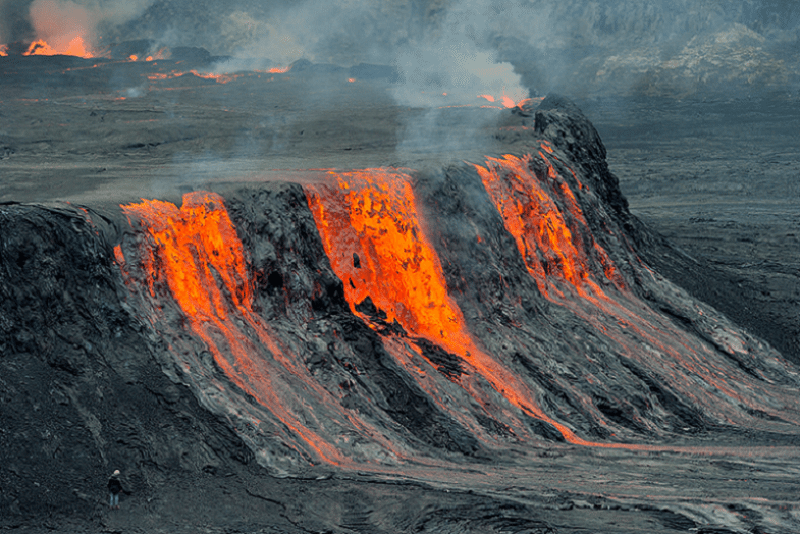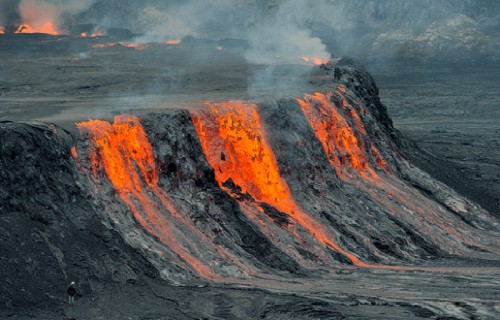Here, we present to you our choice of 5 Completely Unique Volcanoes. That is saying a lot, given the sheer number of volcanoes in the world. These marvels of geology have fascinated…and often terrified…mankind throughout the ages. Yet, like anything else, not all formed exactly like the others. A few stand out from the others in the distinctiveness. We hope you enjoy the article.
Mount Erebus
Mount Erebus Facts
- Looking like something one might expect to see in a movie scene set on another planet, the incredible Mount Erebus ranks as the second highest volcano in its part of the world.
- The mount also forms part of the Pacific Ring of Fire which includes over 160 active volcanoes. The volcano has been continuously active since 1972.
- In fact, this remarkable geological feature remains the most active volcano in its particular, highly remote part of the globe.
- Sir James Clark Ross was the first non-indigenous human in our time to see this sight. He discovered the mount in 1841 during an active eruption.
- The first reach of the summit happened in 1908, and a robotic probe first explored the interior of the volcano in 1992.
Mount Erebus Physical Description
The eerily breathtaking Mount Erebus today ranks as one of the most truly amazing and phenomenal ultra mountains in the world.
The summit of this mesmerizing volcano itself also sits at an incredible altitude of about 12,448 ft (3,794 m) high.
The summit of the mountain also contains a persistent lava lake. This remains one of only five such lava lakes on the planet that humans know of.
Its unique location has also created some unique geological features which exist nowhere else on Earth. The flank of Mount Erebus is covered with hundreds of fumaroles which constantly emit steam.
The unique combination of super-heated steam and sub-freezing temperatures creates gigantic hollow towers of ice. Some of these towers measure as much as roughly 60 ft (18.3 m) in height.
Mount Erebus Location and Modern History
The fantastic Mount Erebus formed on the extremely remote and desolate Ross Island. This island is also located rather deep in the region of Antarctica.
Upon its discovery in 1841, by Sir James Clark Ross, the site was named Erebus, after a particularly dark section of Hades, in ancient Greek mythology.
The site was first explored in detail by a scientific team in December of 1912. Two of the camps used have now been recognized for their historic significance.
The first known successful climb to the crater summit occurred in 1908, by a group led by Sir Ernest Shackleton.
This place would also make an incredible movie set.
Paricutin
Paricutin Facts
- Paricutin is a cinder cone volcano located in the Mexican state of Michoacan and lies close to a village of the same name.
- Unfortunately for the inhabitants, ensuing lava flows subsequently buried the village.
- The volcano is a unique marvel of geology in that its evolution from creation to extinction was witnessed, observed and studied.
- This volcano also appears on many versions of the Seven Natural Wonders of the World.
- Paricutin is part of a volcanic field that covers much of west-central Mexico, in North America, and is also a part of the Ring of Fire.
CCL: http://bit.ly/2xQPH8p
Paricutin History
Firstly, about three weeks prior to the actual eruption, people near Paricutin village heard rumbling noises that resembled thunder. These were actually extremely deep magmatic earthquakes.
Secondly, Paricutin also began as a small fissure in a local cornfield. A local farmer owned the field at the time of the initial eruption. The cone first began forming on February 20, 1943.
The farmer and his wife also witnessed that first eruption of ash and stones first-hand while working in the field. The volcano grew rather quickly, attaining a height of approximately five stories tall in only one week.
Within one month it could be seen from a distance. Much of the volcano’s growth occurred during its first year. This was during the explosive pyroclastic phase.
The nearby village of Paricutin was buried in lava and ash, along with another village. All of the residents had to relocate to vacant land nearby.
CCL: http://bit.ly/2zBWbKi
Paricutin Formation
By the end of the pyroclastic phase, the volcano had grown to 1,102 ft (336 m) in height or as much as the Eiffel Tower.
For the next eight years, the volcano continued erupting. This phase main characteristic was relatively quiet eruptions of lava that seared the surrounding 9.7 sq mi (25 sq km) of land.
The volcano’s activity slowly declined during this period until the last six months of the eruption. During those last six months, violent and explosive activity was frequent. In 1952, the eruption ended and the cone became quiescent.
Paricutin attained a final height of 1,391 ft (424 m) above the cornfield where it began. The volcano has been quiet since then.
Like most cinder cone volcanos, this one is most likely a monogenetic volcano meaning that once it has finished erupting, it will never erupt again. Any new eruptions in a monogenetic volcanic field will erupt in a new location.
Nyiragongo Volcano
Nyiragongo Volcano Facts
- The incredible Nyiragongo Volcano presents a quite unique combination of factors for vulcanologists to study. Investigations of this geological marvel keep geologists rather busy.
- While the volume of its lava lake varies, the average amount of lava it contains makes it the largest regularly maintained lava lake in the world.
- The lava produced by this volcano also has an extremely fluid consistency. This is because it contains an unusually high concentration of alkali-rich volcanic rock.
- Incidentally, it possesses a relatively steep slope. Combined with the fluid consistency of its lava and its proximity to populated areas, this makes it a dangerous volcano.
Nyiragongo Volcano Geological Description
The fabulous Nyiragongo Volcano represents an excellent example of a stratovolcano. It also remains highly (and almost constantly) active.
It also stands quite tall, with a height of 11,380 ft (3,470 m). In addition, the primary crater measures almost 1.25 mi (2 km) wide. Its lava lake adds another distinctive characteristic, having an average depth of nearly 2,000 ft ( 600 m).
Yet the nature of its lava remains its most distinctive feature. Possessing an extremely high alkali ratio, the lava flows rather rapidly down its steep slopes. As a result, downhill flow speeds have been measured at 60 mph (100 kph).
Due to its combination of slope and lava fluidity, its flow speeds represent the fastest currently known to man.
Nyiragongo Volcano Location and History
The Nyiragongo Volcano sits in the Virunga National Park, in the Democratic Republic of the Congo, in Africa. This location places it less than 12 mi (20 km) from a populated area.
Vulcanologists know little of its ancient eruptive history, yet its activity in modern times remains well documented. The volcano has erupted 34 times since 1882. Furthermore, some of these eruptions lasted for years at a time.
This volcano overlaps with several older volcanoes and sits amid hundreds of small cinder cones. Because of its unique dangers, the Nyiragongo Volcano was named as a Decade Volcanoo in 1991.
In March of 2016, the Goma Volcano Observatory discovered that a new vent had opened on the northeast edge of the crater.
Ol Doinyo Lengai
Ol Doinyo Lengai Facts
- Ol Doinyo Lengai ranks as one of the most unusual volcanoes on earth and also possesses extremely unusual attributes.
- These make it the only one of its type on earth. It also constitutes the only active volcano in its region.
- Moreover, eruptions occur rather frequently, though they usually remain minor. The last eruption of significance was in 1998.
- The qualities of its lava are extraordinary, producing a profoundly positive impact on the surrounding environment.
- It is both unique and helpful, which surprises many. This geological marvel serves as a true masterpiece of N.
Ol Doinyo Lengai Geological Distinctiveness
Most remarkably, Ol Doinyo Lengai has been classified as a Carbonatite Volcano. This makes it the only active volcano of its type known to man.
The lava of this stratovolcano also has an extraordinarily low silica content. Its composition consists of more than 50% carbonate, even though this compound rarely appears on the earth’s surface.
By and large, its carbonate is primarily composed of sodium and potassium. This combination is unknown in any other volcano.
In addition, the uniquely formed molten rock actually turns white in color and does it quite rapidly. Incidentally, the viscosity of the lava is incredibly low, and can sometimes be seen to froth like ocean waves as it emerges.
CCL: http://bit.ly/2xQPH8p
Ol Doinyo Lengai Ecological Importance
Ol Doinyo Lengai is a stratovolcano located in northern Tanzania, in Africa. The site looms nearly 9,524 ft (2,903 m) above the Serengeti.
This mountain also forms an integral part of the East African Rift Valley. The composition of its flows is unique, and as a result, it has had a profound impact on the local ecosystem.
Its unique lava actually breaks down quickly when it rains. The resulting runoff has helped lead to the remarkable verdure of the region.
Ol Doinyo Lengai is also quite important to research. Carbonatite, which it produces, is invaluable to the study of rare earth elements. This site is the only actively producing source of these elements.
Kelimutu
Kelimutu Facts
- Kelimutu stands out as a truly remarkable volcano. This marvel of geology is one of the few known volcanoes with 3 calderas.
- Plus, each of these holds a lake, and each also has different colored water.
- The lakes only partially attain their colors as a result of the activities of the volcano. The volcanic gases emitted by fumaroles in the crater of Kelimutu also interact with chemicals in the water of each lake.
- The colors of the lakes actually change from time to time as a result of random periodic alterations in their chemical composition.
Kelimutu Physical Description
Kelimutu resides at an altitude of 5,377 ft (1,639 m) above sea level. Two of the calderas actually share a wall, while the third sits a short distance to the west.
The walls of each one vary in height, with the highest prominence being 157 ft (48 m).
Each caldera also boasts a small lake and the waters of each of these present different colors.
The lone lake to the west typically displays blue water, while the two sharing a wall typically display green and red water.
In addition, these colors change periodically and sometimes include brown and black. Geologists consider Kelimutu inactive since the last eruption was in 1968.
Kelimutu Location and Nature
This marvelous volcano sits on the island of Flores, in Indonesia, in Asia.
Its summit has become highly elongated by geological forces and now has a roughly rectangular shape. The nearest populated area remains the town of Moni, at 50 mi (80 km) away, even today.
Small fumaroles also populate the floors of the calderas.
The powerful gases released by these fumaroles interact with the various chemicals and minerals inherent to the individual lakes. The resulting colors, therefore, present differently as well.
Despite its remoteness, Kelimutu has become a popular tourist attraction.
5 Completely Unique Volcanoes
We sincerely hope that you have enjoyed this listing of 5 Completely Unique Volcanoes. The sheer power and majesty of these marvels of Nature continue to fascinate human beings, even in our modern age. For all our technology, we remain at their mercy, should they choose to erupt. For all its undeniably great beauty, nature nevertheless remains a force to respect.
Check out our other articles on 6 Mysterious Natural Phenomena, 9 Truly Magnificent Mantises, Wonderful Wild Cats of the World


